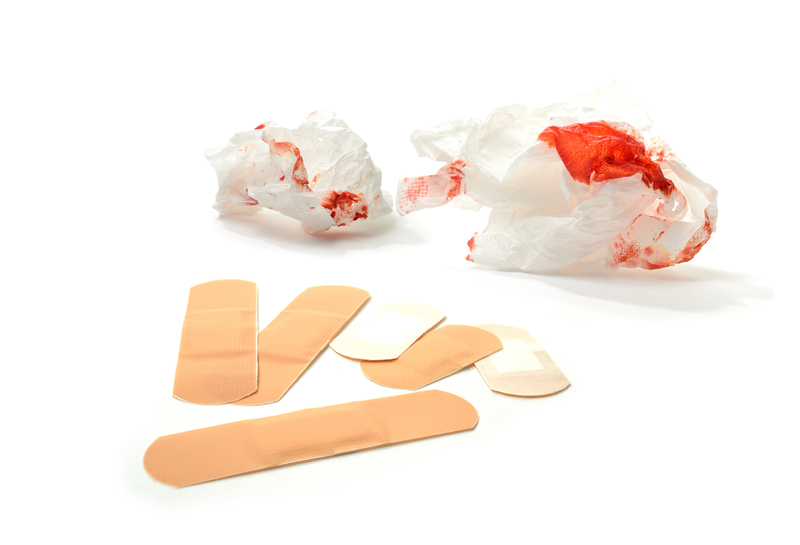Keep Your Curtains Fresh: Expert Cleaning Methods
Posted on 16/06/2025
Keep Your Curtains Fresh: Expert Cleaning Methods
Curtains are more than just decorative elements in your home; they play an essential role in controlling light, maintaining privacy, and even affecting indoor air quality. However, curtains can easily accumulate dust, odors, and allergens over time. To ensure they remain a beautiful and functional part of your space, you need the right curtain cleaning methods. In this comprehensive guide, discover expert curtain cleaning techniques to keep your drapes and curtains looking and smelling fresh--no matter what style or fabric you own.
Why Regular Curtain Cleaning is Essential
- Dust and Allergens: Curtains act as filters, trapping dust, pollen, pet dander, and airborne particles. Without regular cleaning, these accumulations can cause allergies and respiratory issues.
- Odor Control: Fabric absorbs smells easily--from cooking, smoke, and even unseen mold or mildew--diminishing your indoor air quality and fresh atmosphere.
- Preserving Fabric Quality: Dirt and debris can wear down curtain fibers, leading to faded colors and premature aging of your window treatments.
- Aesthetic Appeal: Clean, crisp curtains instantly uplift any room, making spaces feel more inviting and well-maintained.
By maintaining a regular curtain cleaning routine, you protect your investment and improve your home's environment. Now, let's explore expert curtain care and cleaning methods suited to different materials and lifestyles!

Understanding Your Curtain Fabric
Before diving into any cleaning technique, always check the curtain's care label. Fabric types determine the best method for washing curtains. The most common materials include:
- Synthetics (polyester, nylon, acrylic)
- Natural fibers (cotton, linen, silk, wool)
- Velvet and luxury fabrics
- Sheer and delicate curtains
Improper cleaning can shrink, fade, or damage certain materials. When in doubt, opt for a gentle approach or seek professional help for expensive or intricate window coverings.
Top Curtain Cleaning Methods: Expert Tips
1. Vacuuming Curtains: The First Line of Defense
Frequent vacuuming is one of the simplest ways to keep curtains fresh between deeper cleans. Using the soft brush attachment, gently sweep from top to bottom to remove surface dust, pet hair, and lint. For heavy drapes or pleated designs, use the crevice tool to reach into folds, hems, and trim sections.
- Tip: Vacuum once per week in high-traffic rooms or if you have pets.
- Bonus: This reduces airborne allergens and preserves fabric quality.
2. Spot Cleaning for Stains
Accidents happen--food, drink, or ink can leave unsightly stains on your curtains. Immediate spot-cleaning is crucial for minimizing permanent damage:
- Blot (don't rub!) the stain with a clean white cloth to absorb excess liquid.
- Use a mild detergent solution (1 teaspoon in 1 cup lukewarm water) and test on an inconspicuous area first.
- Dab gently with a soft sponge or cloth, working from the outside of the stain inward.
- Allow the area to air dry.
*For oil-based stains or ink, a small amount of rubbing alcohol on a cotton swab can help, but always check the fabric label first.*
3. Steam Cleaning Curtains
Steam cleaning is a powerful way to refresh curtains while they're still hanging. The heat kills dust mites and bacteria, loosens dirt, and deodorizes in one step. Here's how:
- Fill your garment steamer or steam cleaner with clean water.
- Hold the appliance a few inches from the fabric and move downward in slow, steady strokes.
- Pay extra attention to densely gathered areas and hems.
- Caution: Delicate fabrics like silk may not tolerate high-heat steam. Always test first or refer to manufacturer recommendations.
4. Machine Washing Curtains
Many everyday curtain fabrics (cotton, polyester blends, some sheers) are machine-washable. Follow these steps for optimal results:
- Remove hooks, rings, and detachable trims.
- Shake the curtains outdoors to remove dust.
- Use a gentle cycle and mild liquid detergent. Avoid bleach.
- Wash at cold or lukewarm temperatures to prevent shrinkage.
- Dry on a low-heat setting or hang damp curtains back on the rod to air-dry and prevent wrinkles.
Pro tip: Wash one panel at a time for larger curtains to avoid tangling.
5. Hand Washing Curtains: When to Take Extra Care
Delicate, vintage, or embellished curtains require special handling. Here's an expert hand-washing technique:
- Fill a bathtub or large basin with lukewarm water and a mild detergent.
- Gently agitate the curtain by hand, soaking for 5-10 minutes.
- Rinse thoroughly with cold water until all soap is removed.
- Squeeze out excess water gently--never wring or twist the fabric.
- Lay flat on a clean towel, roll it up to blot, then hang to air dry.
This method is ideal for lace, silk, and certain sheers.
6. Professional Dry Cleaning
For curtains made from luxury fabrics (velvet, silk, wool blends), those with intricate hand-sewing, or stubborn stains that resist home treatment, professional dry cleaning is often the safest option.
- Check the label: If it says "Dry Clean Only," always follow the recommendation to preserve the shape, color, and finish of your window treatments.
- Request gentle or specialty cleaning services for extra-fine materials.
Many professional cleaning companies also offer in-home services for large or difficult-to-remove draperies, saving you time and hassle.
Special Curtain Care Techniques
Odor Removal Tips
Even after cleaning, lingering smells from smoke, cooking, or pets can persist in curtain fabrics. Try these expert odor-busting ideas:
- Sprinkle baking soda lightly on dry curtains, leave for 30 minutes, then vacuum off.
- Hang curtains outside on a breezy, sunny day for natural deodorizing and disinfection.
- Use a fabric-safe spray (such as diluted white vinegar) and mist lightly, allowing the curtain to air dry.
- Place an open container of activated charcoal near windows to continuously absorb odors.
Prevent Mold and Mildew on Curtains
Dampness and humidity can lead to mold or mildew growth on curtain fabrics--especially in bathrooms, kitchens, or basements. Guard against this with these practices:
- Keep windows well-ventilated or use a dehumidifier.
- Wash or steam-clean curtains more frequently in damp climates.
- Ensure curtains are completely dry after washing before hanging them back.
- Inspect regularly for any signs of spots or musty odors.
Protecting Curtains from Sun Damage
Prolonged exposure to sunlight fades and weakens curtain fabric. Expert cleaning goes hand-in-hand with smart protection:
- Use UV-blocking window film or sheers as a buffer for heavy drapes.
- Rotate curtain panels every few months to even out fading.
- Avoid harsh chemical cleaners or bleach, which worsen sun damage effects.
Seasonal Curtain Maintenance Checklist
To keep curtains looking fresh year-round, incorporate these tasks into your seasonal cleaning schedule:
- Spring: Deep-clean curtains, check for wear or fading, and freshen up rods and tiebacks.
- Summer: Increase vacuuming and odor control in humid months.
- Autumn: Steam clean to remove summer pollen and dust build-up.
- Winter: Wash or dry clean curtains before sealing windows for warmth; spot treat any stains from holiday entertaining.
Frequently Asked Questions About Curtain Cleaning
How often should I clean my curtains?
For most homes, vacuuming every one to two weeks and deep-cleaning every 6-12 months is sufficient. If you live in a dusty area, suffer from allergies, or have pets, clean more often.
Can blackout or thermal curtains be cleaned at home?
Yes, but check the care label! Many blackout curtains have a special lining that can be damaged by hot water or harsh detergents. Vacuum regularly and spot clean; for deep cleaning, stick to hand washing or consult a professional.
What is the best way to remove wrinkles from curtains?
Hang damp curtains directly after washing for gravity-assisted wrinkle removal, or use a handheld fabric steamer. Avoid irons unless the label says it's safe, as high heat can scorch or shine certain materials.
Expert Curtain Care Dos and Don'ts
- Do read and follow the manufacturer's instructions for care and cleaning.
- Do test detergents on a hidden area before treating stains.
- Do air dry curtains whenever possible to prevent shrinkage and fading.
- Don't overload your washing machine with heavy curtain panels.
- Don't use strong bleaching agents that can ruin fabric color and texture.
- Don't rehang curtains while they're still damp in places prone to mold.

When to Replace Your Curtains
No matter how diligent your curtain cleaning routine is, fabric has a finite lifespan. Signs it might be time for new curtains include:
- Persistent odors that resist all cleaning methods
- Noticeable thinning, fraying, or holes in the fabric
- Sun bleaching that affects the curtain's appearance and function
- Outdated styles that no longer fit your decor
Conclusion: Enjoy Fresh, Beautiful Curtains for Years
By adopting these expert curtain cleaning methods, you can enjoy vibrant, hygienic window treatments that enhance your home's charm and comfort. Whether you prefer quick routine maintenance or an in-depth seasonal refresh, knowing how to take care of curtains ensures they last longer and always look their best.
Remember, your curtains are an investment in your living space's atmosphere. With the right approach to keeping curtains fresh, you'll enjoy healthier, cleaner air and a more stylish home every day. Start incorporating these expert cleaning tips into your routine--and let your curtains shine!




